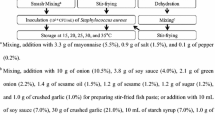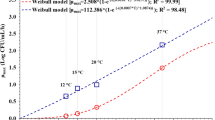Summary
The effects of storage atmosphere and temperatures onSalmonella typhimurium and aerobic plate count (APC) in meat were studied. Experimental results were analysed by non-linear regression of modified-Gompertz and logistic equations to generate “best fit”. In the absence of CO2 in package (with air and 40% O2+60% N2), in the refrigerator and at 12°C,S. typhimurium had higher growth rate and reached to higher number, whereas the presence of CO2 from 40 to 100% reduced the number ofS. typhimurium by 0.2 to 1.6 logs unit in the refrigerator. CO2 dissolves in water to form carbonic acid which reduces pH of meat and bacterial cytoplasm. This would be reduced the bacteria or inhibited their growth. The effects of the modified atmospheres on microorganisms in meat seems to be responsible for the data obtained, together with a probable contribution from pH which in turns is likely to be influenced by the gas atmosphere. It is known that CO2 has a bacteriostatic effect. Parameters of non-linear modified-Gompertz and logistic models of theS. typhimurium and APC in meat stored at variaus atmospheres were matched in a satisfactory way. Both the modified-Gompertz and logistic models showed good fit to all curves as assessed using the root mean square error and the correlation coefficient between the experimental and predicted values.
Similar content being viewed by others
References
Bodnaruk P., Draughon F.A. (1998). Effect of packaging atmosphere and pH on the virulence and growth ofYersinia enterocolitica on pork stored at 4°C. Food Microbiology, 15: 129–136.
Bozkurt H., Erkmen O. (1999). Modeling in protection and prediction of food quality. Food Technology, 4 (1): 63–70.
Buchanan R.L. (1993). Predictive food microbiology. Trends in Food Science and Technology, 4: 6–11.
Chowdhury B.R., Chakraborty R., Chaudhuri U.R. (2007). Validity of modified Gompertz and logistic models in predicting cell growth ofPediococcus acidilactici H during the production of bacteriocin pediocin AcH. Journal of Food Engineering, 80: 1171–1175.
Daniels J.A., Krishnamurthy R., Rizvi S.S.H. (1985). A review of effects of CO2 on microbial growth and food quality. Journal of Food Protection, 48: 532–537.
Erkmen O. (2001). Matmematical modeling ofEscherichia coli inactivation under high-pressure carbon dioxide. Journal of Bioscience and Bioengineering, 92: 39–43.
Erkmen O. (2003). Mathematical modelling ofSaccharomyces cerevisiae inactivation under high pressure carbon dioxide. Nahrung/Food 47: 176–180.
Erkmen O. (2007). Basic Methods for the Microbiological Analysis of Foods. Nobel Publishing and Distribution Company, Ankara, pp. 140–158.
Gallo L.I., Pilosof A.M.R., Jagus R.J. (2006). Effective control ofListeria innocua by combination of nisin, pH and low temperature in liquid cheese whey. Food Control, 18: 1086–1092.
Giannuzzi L. (1998). Mathematical modelling of microbial growth in fresh filled pasta stored at different temperatures. Journal of Food Processing, 22: 443–447.
Gil M.M., Brandao T.R.S., Silva C.L.M. (2006). A modified Gompertz model to predict microbial inactivation under timevarying temperature conditions. Journal of Food Engineering, 76: 89–94.
Hintlian B.C., Hotchkiss J.P. (1987). Microbiological and sensory evaluation of cooked roast beef packed in a modified atmosphere. Journal of Food Processing and Preservation, 11: 171–179.
Juneja V.K., Melendres M.V., Huang L., Gumudavelli V., Subbiah J., Thippareddi H.T. (2007). Modeling the effect of temperature on growth ofSalmonella in chicken. Food Microbiology, 24: 328–335.
Kajak K., Koŀozyn-Krajewska D. (2006). Construction of predictive models of growth of microorganisms in salted and cured meat products. Innovative Food Science and Emerging Technologies, 7: 152–159.
López-Mendoza M.C., Ruiz P., Mata C.M. (2007). Combined effects of nisin, lactic acid and modified atmosphere packaging on the survival ofListeria monocytogenes in raw ground pork. International Journal of Food Science and Technology, 42: 562–566.
McMeekin T.A., Ross T. (2002). Predictive microbiology: providing a knowledge-based framework for change management. International Journal of Food Microbiology, 78 (1–2): 133–153.
McMeekin T. A., Ross T., Olley J. (1992). Application of predictive microbiology to asses the quality and safety of fish and fish products (review). International Journal Food Microbiology, 15 (1/2): 13–32.
McMeeken T.A., Olley J.N., Ross T., Ratkowsky D.A. (1993). Predictive Microbiology: Theory and Application, Research Studies Press Ltd., Taunton.
Muarmans M.L.T., Stekelenburg F.K., Zwietering M.H., Huis In T Veld L.H.J. (1993). Modeling of the microbiological quality of meat. Food Control, 4: 216–221
Nissen H., Alvseike O., Bredholt S., Holck A., Nesbakken T. (2000). Comparison between the growth ofYersinia enterocolitica, Listeria monocytogenes, Escherichia coli 0157:H7 andSalmonella spp. in ground beef packed by three commercially used packaging techniques. International Journal of Food Microbiology, 59: 211–220.
Palumbo S., Williams A., Buchanan R., Phillips J. (1992). Model for anaerobic growth ofAeromonas hydrophila K144. Journal of Food Protection, 55: 260–265.
Pernia S., Andrewb P.W., Shama G. (2005). Estimating the maximum growth rate from microbial growth curves: definition is everything. Food Microbiology, 22: 491–495.
Pin C., Baranyi J., de Fernando G.G. (2000). Predictive model for growth ofYersinia enterocolitica under modified atmospheres. Journal of Applied Microbiology, 88: 521–530.
Rao D.N., Sachindra N.M. (2002). Modified atmosphere and vacuum packaging of meat and poultry products. Food Reviews International, 18 (4): 263–293.
Ray B. (1996). Fundamental Food Microbiology, CRC Press Inc., New York.
Skandamis P., Tsigarida E., Nychas G-J.E. (2002). The effect of oregano essential oil on survival/death ofSalmonella typhimurium in meat stored at 5°C under aerobic, VP/MAP conditions. Food Microbiology, 19: 97–103.
van Impe F.F., Nicolai B.M., Martens T., Baerdemaeker J.D., Vandewalle J. (1992). Dynamic mathematical model to predict microbial growth and inactivation during food processing. Applied and Environmental Microbiology, 58: 2901–2909.
Walker S., Jones J. (1994). Microbiology modeling and safety assessment. Food Technology Internationa-Europe, Stirling Publications, pp. 25–29.
Zardetto S. (2005). Effect of modified atmosphere packaging at abuse temperature on the growth ofPenicillum aurantiogriseum isolated from fresh filled pasta. Food Microbiology, 22: 367–371.
Zwietering M.H., Jongenburger I., Rombouts F.M., van’t Riet K. (1990). Modeling of bacterial growth curve. Applied and Environmental Microbiology, 56, 1875–1881.
Author information
Authors and Affiliations
Corresponding author
Rights and permissions
About this article
Cite this article
Erkmen, O., Barazi, A. Modelling the effects of modified atmosphere onSalmonella typhimurium in packaged meat during storage in the refrigerator and at 12°C. Ann. Microbiol. 58, 73–81 (2008). https://doi.org/10.1007/BF03179448
Received:
Accepted:
Issue Date:
DOI: https://doi.org/10.1007/BF03179448




